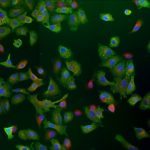Lien vers Pubmed [PMID] – 20041119
Lien DOI – e849510.1371/journal.pone.0008495
PLoS One 2009 Dec; 4(12): e8495
The major role of the neuraminidase (NA) protein of influenza A virus is related to its sialidase activity, which disrupts the interaction between the envelope hemagglutinin (HA) protein and the sialic acid receptors expressed at the surface of infected cells. This enzymatic activity is known to promote the release and spread of progeny viral particles following their production by infected cells, but a potential role of NA in earlier steps of the viral life cycle has never been clearly demonstrated. In this study we have examined the impact of NA expression on influenza HA-mediated viral membrane fusion and virion infectivity.The role of NA in the early stages of influenza virus replication was examined using a cell-cell fusion assay that mimics HA-mediated membrane fusion, and a virion infectivity assay using HIV-based pseudoparticles expressing influenza HA and/or NA proteins. In the cell-cell fusion assay, which bypasses the endocytocytosis step that is characteristic of influenza virus entry, we found that in proper HA maturation conditions, NA clearly enhanced fusion in a dose-dependent manner. Similarly, expression of NA at the surface of pseudoparticles significantly enhanced virion infectivity. Further experiments using exogenous soluble NA revealed that the most likely mechanism for enhancement of fusion and infectivity by NA was related to desialylation of virion-expressed HA.The NA protein of influenza A virus is not only required for virion release and spread but also plays a critical role in virion infectivity and HA-mediated membrane fusion.


